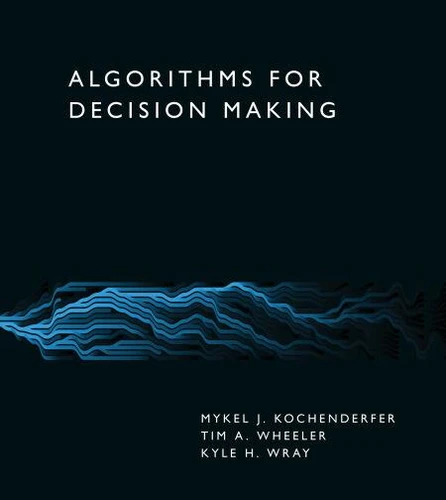Algorithms for Decision Making
Par : , ,Formats :
Disponible dans votre compte client Decitre ou Furet du Nord dès validation de votre commande. Le format ePub protégé est :
- Compatible avec une lecture sur My Vivlio (smartphone, tablette, ordinateur)
- Compatible avec une lecture sur liseuses Vivlio
- Pour les liseuses autres que Vivlio, vous devez utiliser le logiciel Adobe Digital Edition. Non compatible avec la lecture sur les liseuses Kindle, Remarkable et Sony
- Non compatible avec un achat hors France métropolitaine
 , qui est-ce ?
, qui est-ce ?Notre partenaire de plateforme de lecture numérique où vous retrouverez l'ensemble de vos ebooks gratuitement
Pour en savoir plus sur nos ebooks, consultez notre aide en ligne ici
- Nombre de pages700
- FormatePub
- ISBN978-0-262-37023-3
- EAN9780262370233
- Date de parution16/08/2022
- Protection num.Adobe DRM
- Taille53 Mo
- Infos supplémentairesepub
- ÉditeurThe MIT Press
Résumé
A broad introduction to algorithms for decision making under uncertainty, introducing the underlying mathematical problem formulations and the algorithms for solving them. Automated decision-making systems or decision-support systems-used in applications that range from aircraft collision avoidance to breast cancer screening-must be designed to account for various sources of uncertainty while carefully balancing multiple objectives.
This textbook provides a broad introduction to algorithms for decision making under uncertainty, covering the underlying mathematical problem formulations and the algorithms for solving them. The book first addresses the problem of reasoning about uncertainty and objectives in simple decisions at a single point in time, and then turns to sequential decision problems in stochastic environments where the outcomes of our actions are uncertain.
It goes on to address model uncertainty, when we do not start with a known model and must learn how to act through interaction with the environment; state uncertainty, in which we do not know the current state of the environment due to imperfect perceptual information; and decision contexts involving multiple agents. The book focuses primarily on planning and reinforcement learning, although some of the techniques presented draw on elements of supervised learning and optimization.
Algorithms are implemented in the Julia programming language. Figures, examples, and exercises convey the intuition behind the various approaches presented.
This textbook provides a broad introduction to algorithms for decision making under uncertainty, covering the underlying mathematical problem formulations and the algorithms for solving them. The book first addresses the problem of reasoning about uncertainty and objectives in simple decisions at a single point in time, and then turns to sequential decision problems in stochastic environments where the outcomes of our actions are uncertain.
It goes on to address model uncertainty, when we do not start with a known model and must learn how to act through interaction with the environment; state uncertainty, in which we do not know the current state of the environment due to imperfect perceptual information; and decision contexts involving multiple agents. The book focuses primarily on planning and reinforcement learning, although some of the techniques presented draw on elements of supervised learning and optimization.
Algorithms are implemented in the Julia programming language. Figures, examples, and exercises convey the intuition behind the various approaches presented.
A broad introduction to algorithms for decision making under uncertainty, introducing the underlying mathematical problem formulations and the algorithms for solving them. Automated decision-making systems or decision-support systems-used in applications that range from aircraft collision avoidance to breast cancer screening-must be designed to account for various sources of uncertainty while carefully balancing multiple objectives.
This textbook provides a broad introduction to algorithms for decision making under uncertainty, covering the underlying mathematical problem formulations and the algorithms for solving them. The book first addresses the problem of reasoning about uncertainty and objectives in simple decisions at a single point in time, and then turns to sequential decision problems in stochastic environments where the outcomes of our actions are uncertain.
It goes on to address model uncertainty, when we do not start with a known model and must learn how to act through interaction with the environment; state uncertainty, in which we do not know the current state of the environment due to imperfect perceptual information; and decision contexts involving multiple agents. The book focuses primarily on planning and reinforcement learning, although some of the techniques presented draw on elements of supervised learning and optimization.
Algorithms are implemented in the Julia programming language. Figures, examples, and exercises convey the intuition behind the various approaches presented.
This textbook provides a broad introduction to algorithms for decision making under uncertainty, covering the underlying mathematical problem formulations and the algorithms for solving them. The book first addresses the problem of reasoning about uncertainty and objectives in simple decisions at a single point in time, and then turns to sequential decision problems in stochastic environments where the outcomes of our actions are uncertain.
It goes on to address model uncertainty, when we do not start with a known model and must learn how to act through interaction with the environment; state uncertainty, in which we do not know the current state of the environment due to imperfect perceptual information; and decision contexts involving multiple agents. The book focuses primarily on planning and reinforcement learning, although some of the techniques presented draw on elements of supervised learning and optimization.
Algorithms are implemented in the Julia programming language. Figures, examples, and exercises convey the intuition behind the various approaches presented.



